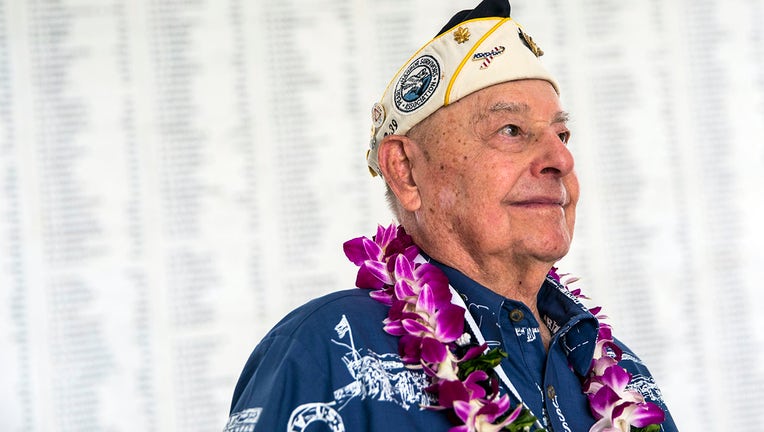Pearl Harbor’s last USS Arizona battleship survivor dies at 102

File: U.S.S. Arizona survivor Lou Conter looks on near the Arizona Remembrance Wall during a memorial service marking the 74th Anniversary of the attack on the U.S. naval base at Pearl Harbor December 07, 2015. (Photo by Kent Nishimura/Getty Images)
The last living survivor of the USS Arizona battleship that exploded during the Japanese bombing of Pearl Harbor has died.
Lou Conter, who was 102, passed away in his California home on Monday from congestive heart failure, Louann Daley, his daughter, told the Associated Press.
Conter was a quartermaster who stood on the main deck of the Arizona when Japanese planes flew overhead on the morning of Dec. 7, 1941.

File: Louis "Lou" Conter, a Pearl Harbor survivor, poses for a photo during the 76th Commemoration Event of the attacks on Pearl Harbor and Oahu at Joint Base Pearl Harbor-Hickam in 2017. (U.S. Navy photo by Mass Communication Specialist 2nd Class Katarzyna Kobiljak)
Conter recalled how one bomb penetrated steel decks 13 minutes into the battle and set off over 1 million pounds (450,000 kilograms) of gunpowder stored below.
"Guys were running out of the fire and trying to jump over the sides," Conter said. "Oil all over the sea was burning."
His autobiography "The Lou Conter Story" recounts how he joined other survivors in tending to the injured, many of whom were blinded and badly burned. The sailors only abandoned ship when their senior surviving officer was sure they had rescued all those still alive.

File: Retired Master Chief Jim Taylor, right, Pearl Harbor Survivor Liaison at Navy Region Hawaii, greets Lou Conter, a USS Arizona (BB 39) Pearl Harbor Survivor, before the start of the 72nd anniversary commemoration of the Dec. 7, 1941 attack on Pe
RELATED: Pearl Harbor survivor Richard Higgins, one of few remaining, dies at 102
After Pearl Harbor
Conter went to flight school after Pearl Harbor, earning his wings to fly PBY patrol bombers, which the Navy used to look for submarines and bomb enemy targets. He flew 200 combat missions in the Pacific with a "Black Cats" squadron, which conducted dive bombing at night in planes painted black.
In 1943, he and his crew had to avoid a dozen sharks after they were shot down near New Guinea. A sailor expressed doubt they would survive, to which Conter replied, "baloney."
"Don’t ever panic in any situation. Survive is the first thing you tell them. Don’t panic or you’re dead," he said. They were quiet and treaded water until another plane came hours later and dropped them a lifeboat.
In the late 1950s, he was made the Navy’s first SERE officer — an acronym for survival, evasion, resistance and escape. He spent the next decade training Navy pilots and crew on how to survive if they’re shot down in the jungle and captured as a prisoner of war. Some of his pupils used his lessons as POWs in Vietnam.
Conter retired in 1967 after 28 years in the Navy.
In his later years, Conter became a fixture at annual remembrance ceremonies in Pearl Harbor that the Navy and the National Park Service jointly hosted on the anniversaries of the 1941 attack. When he lacked the strength to attend in person, he recorded video messages for the audience and watched remotely from his home in California.
In 2019, when he was 98, he said he liked going to remember those who lost their lives.
"It’s always good to come back and pay respect to them and give them the top honors that they deserve," he said.
Though many treated the shrinking group of Pearl Harbor survivors as heroes, Conter refused the label.
"The 2,403 men that died are the heroes. And we’ve got to honor them ahead of everybody else. And I’ve said that every time, and I think it should be stressed," Conter told The Associated Press in a 2022 interview at his California home.
The Associated Press contributed to this report. This story was reported from Los Angeles.

